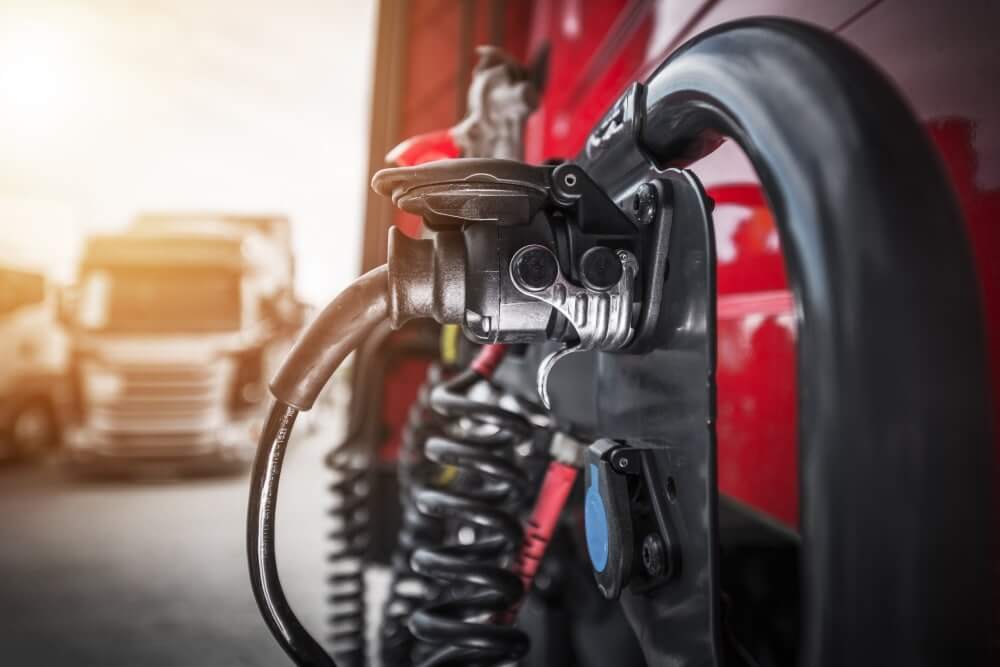Now that a growing number of shippers are requesting zero emissions transport and electric vehicles (EVs) are becoming increasingly cost-effective, transport companies across Canada are gearing up to electrify their fleets.
But how do EV maintenance costs compare with their traditional, internal combustion engine (ICE) counterparts? According to Consumer Reports, the difference is stark: owners of fully electric and plug-in hybrid vehicles pay half as much as ICE owners on maintenance and repairs.
Thankfully, electric car owners aren’t the only ones who can maximize savings on maintenance and repair. Keep reading to find out how EV maintenance costs compare with ICE vehicles for fleets.
EV maintenance costs: what is current research saying?
Many studies have focused on EV maintenance costs associated with light-duty vehicles. However, an increasing amount of research is highlighting the potential for maintenance savings associated with medium- to heavy-duty EVs.
For example, research cited in a U.S. Department of Energy report in 2021 found significant differences in maintenance and repair costs when comparing different kinds of transit buses.
- Battery-powered electric buses averaged at US$0.26 per mile
- Hybrid buses cost US$0.32 per mile
- Diesel buses cost US$0.46 per mile
For any fleet operator seeking to offset the initial cost of leasing or purchasing an EV truck or bus, these results are striking. Better yet, understanding these EV maintenance costs is also surprisingly straightforward.
Additionally, a recent EDF report looking at Class 3-8 vehicles found rapidly declining costs for zero emitting trucks and buses. What’s more, the cost of owning an EV purchased in 2027 is projected to be lower than its diesel counterparts over the vehicle’s lifespan. This tells us that while cost parity is not there for all segments yet, it is coming, and today’s electric vehicles already have sufficient ranges for most regional return-to-base applications.
How can EV maintenance result in savings on fleet operation costs?
Although EV and ICE vehicles share some of the same maintenance and repair costs, such as power steering, suspension, and door locks, there are features that make EVs distinct.
Key areas where EVs can save on maintenance and repairs include:
- Their simpler structure
- Their regenerative braking systems
- Their batteries
What impact could the simpler structure of an EV have on fleet operation costs?
One feature of EVs that delivers clear maintenance and repair savings is their comparatively simple structure. The number of moving parts in an EV drivetrain could be as few as 20, whereas an ICE vehicle could have as many as 2000.
Because they have fewer moving parts, EVs are associated with a reduction in service, maintenance, and repair (SMR) costs compared to traditional ICE engines, which makes things easier on drivers and mechanics.
EVs also have fewer fluids in need of changing than their ICE counterparts. For instance, the oil needed to lubricate the engine parts of a traditional vehicle isn’t required in an EV.
However, there are some fluids that are still essential for an EV, such as:
- Battery coolant
- Brake fluid
- Common lubricants like windshield washer fluid, steering fluid, air conditioning refrigerant, and grease for door locks, suspension systems, and small moving parts
How does regenerative braking affect EV maintenance costs?
By now, regenerative braking has become a trademark of EVs. The most famous benefit of regenerative braking is its ability to capture the kinetic energy of a vehicle during braking and then store it in the vehicle’s battery. This can help to extend the vehicle’s range.
For example, Volvo has estimated that its VNR Electric truck can return up to 15% of energy back to its battery thanks to its regenerative braking system.
Regenerative braking also has some impressive effects on EV maintenance costs.
- EVs come with both regenerative braking and conventional hydraulic brakes. However, regenerative braking does most of the heavy lifting when slowing a vehicle.
- This means that brake pads and rotors are used far less frequently and last longer between servicing, which can dramatically reduce EV maintenance costs.
Keep in mind that an EV’s brakes will still need to be inspected on a regular basis as per the manufacturer’s maintenance schedule.
How can EV batteries help a fleet save on maintenance costs?
As the most expensive component of an EV, the battery might seem like the part that would require the most attention when it comes to maintenance. However, an EV battery can also play an important role in keeping EV maintenance costs low.
Consider the following factors:
- Generally, EV batteries are under warranty for six to eight years or 100,000 miles.
- EV batteries are designed to last for the expected lifespan of the vehicle, with current predictions estimating that an EV battery could even last up to 16 years before it needs to be replaced. That’s compared to a battery for an ICE vehicle, which is estimated to last between three and seven years.
Like ICE batteries (or even smartphone batteries), EV batteries designed for extended life suffer some degradation over time. However, there are practical steps that drivers and fleet managers can take to keep a battery healthy and save on maintenance costs:
- Don’t charge an EV when it doesn’t need to be charged (charger software can help manage and optimize this)
- Try to keep the battery charge between 20% and 80%
- Never let the battery discharge completely
- If you know that your EV will be idle for a long period of time, don’t leave it with a full or empty battery. Charging the vehicle to somewhere between 25% or 75% before storing it can help prevent excess degradation
Aside from saving on maintenance and repair costs, cheaper prices for EV batteries are on the horizon. Since 2010, the price of lithium-ion batteries has dropped by an incredible 80% and is set to fall even further in the near future.
EV maintenance cost savings are great, but how should a fleet manager prepare?
To recap, medium- and heavy-duty EVs can quickly lead to significant savings on maintenance compared to ICE models.
However, that doesn’t mean EVs don’t require regular maintenance. Just like ICE vehicles, brake pads, tires, and fluids all need to be checked regularly. While your EV might not need to be serviced as frequently as an ICE vehicle, that doesn’t mean it won’t need a quick trip to the mechanic every now and then.
To ensure your fleet reaps the full benefits of lower maintenance costs, remember to do the following:
- Prepare your drivers, depot staff, and mechanics by investing in EV-specific training. This will help ensure the comfort and safety of employees as well as the smooth running of your business. Many training courses already exist across Canada, especially in British Columbia and Montreal. If your fleet is based in Quebec, you’re in luck: the Government of Quebec’s Transportez vert program provides funding to help pay for training.
- Always check the warranty and servicing schedule of a new EV with the OEM.
- Work with a trusted partner to ensure your fleet electrification goes smoothly and keep maintenance costs down. When you lease EVs and chargers with 7Gen, you have the added convenience of being able to rely on our team for 24/7 support and troubleshooting. Plus, for fleets located in British Columbia, 7Gen includes a full-service maintenance and repair plan in all its leasing packages, eliminating all maintenance costs.
Curious about how 7Gen can help you secure competitive pricing and manage the maintenance of your new technology? Contact a member of the 7Gen team today!




